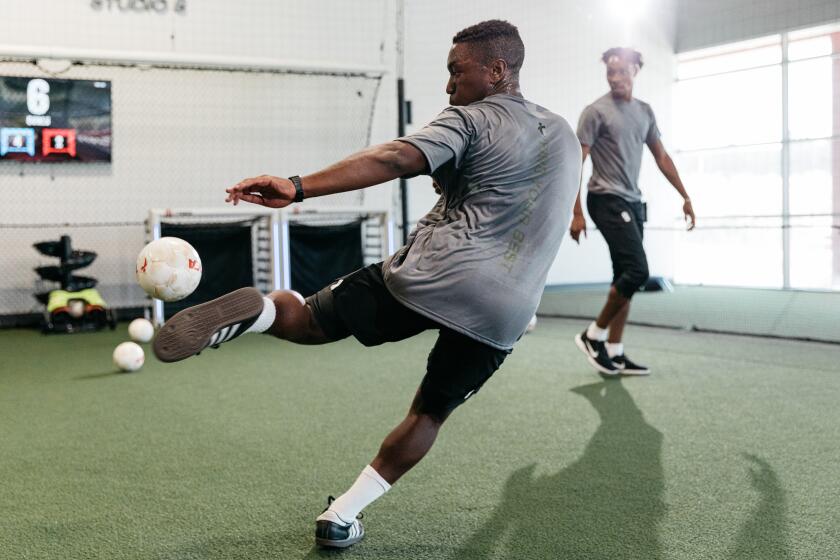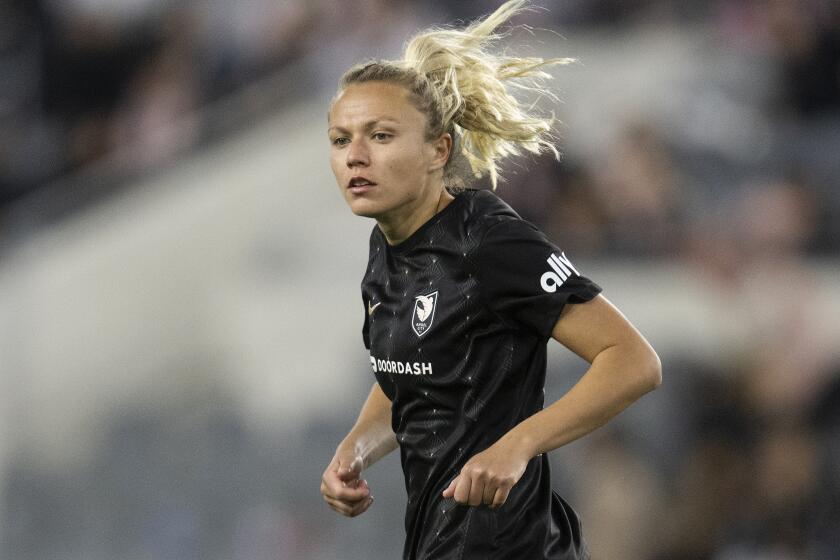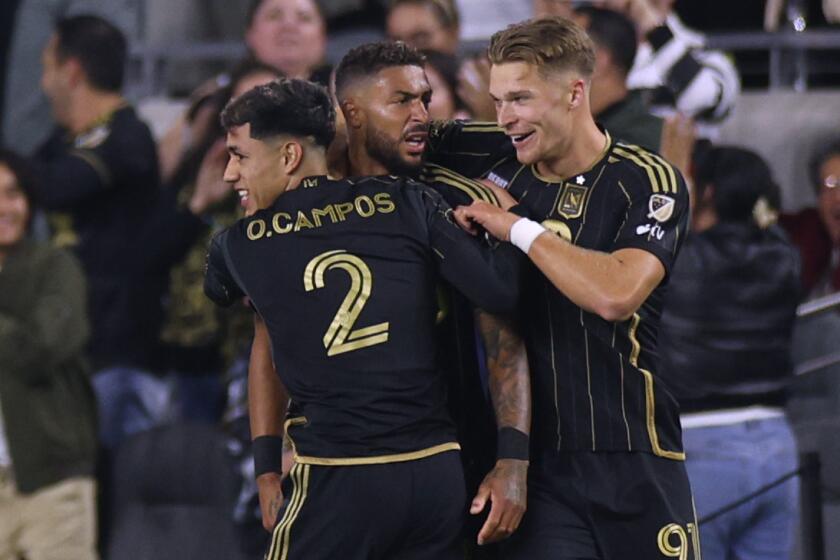Parents and Kids Get a Kick Out of Soccer League
Bob Darretta stood eagerly on the sidelines, video camera balanced on his shoulder, carefully taping his son Colin’s soccer game for a post-game review at home. It was near the end of the season and there wasn’t much time left for improvement.
Not that this is supposed to be a competitive enterprise. Oh no.
Parents and coaches in the American Youth Soccer Organization’s littlest league--called the Kindergarten Division, or K Division for short--aren’t even allowed to keep score.
Still, that doesn’t stop these parents from yelling themselves hoarse as they cheer their 5-year-old daughters and sons.
“What are you guys doing, playing soccer or having a party?” shouted an enthusiastic parent one recent Saturday, as pint-sized members of the Turbos and Hawks squared off in center field of Jackie Robinson Memorial Park in Pasadena.
“It’s a wild show to see this going on,” remarked AYSO Region 13 Commissioner Myles Standish, one of the K Division’s most ardent champions, as he stood on the sidelines of the Turbos-Hawks game. “It’s a healthy sport. There’s a lot of running.”
Region 13, which includes the Pasadena, Altadena and La Canada areas, has been growing at an annual rate of about 10% for the past three years, reflecting the phenomenal expansion of AYSO nationwide, Standish said.
Since its founding in 1964, the Hawthorne-based soccer organization has grown to more than 330,000 players throughout the country, about 25,000 in the K Division alone, said Kris Kearney, spokeswoman for the national office of AYSO.
In Region 13, there are 1,895 soccer-playing youths aged 5 to 18, including 154 kindergartners belonging to 14 teams, Standish said. The K Division league is part of AYSO’s West San Gabriel Valley area, which stretches from East Los Angeles to Monrovia and has about 10,000 players.
“We’re running out of fields,” Standish said. “A number of our (Southern California) regions are limited by the availability of playing fields.”
Part of the appeal is the soccer league’s emphasis on player involvement. Players, who pay a yearly $40 registration fee, are assured of participating in at least two quarters of every game they attend.
“Nobody sits on the bench all game. Little League can pull that. We don’t,” said Standish, surveying his league’s 10 playing fields just south of the Rose Bowl. “With soccer, you get average and below-average kids out there playing, and they still aren’t uncomfortable.”
Indeed, the AYSO motto is “Everyone plays.”
And for the K Division, that could rightly be changed to “Everyone plays at the same time.”
All team members who show up for a game are allowed to play simultaneously--up to 11 players on each side. In the kindergarten league, boys and girls play together, although they separate into same-sex teams after the first year. Teams start keeping track of wins and losses when players hit the 8- and 9-year-old level.
The kindergartners play on half-sized fields with smaller-than-regulation soccer balls.
But the game’s primary objective, scoring goals, isn’t always obvious. Most of the kindergartners seem to have a general concept of how the game is played, but are easily distracted. Then there are a few young dreamers, talkers and gawkers who run about randomly. Without adults on the field, most matches would quickly regress into a game of playground tag.
Parents do triple duty as coaches, referees and fans. Sometimes they also play Mommy.
“No crying, OK? We’re not going to have that,” Coach Rhonda Stone said kindly but firmly as her team, the Golden Eagles, gathered around her with hopeful faces, rosy cheeks and runny noses during a halftime break.
Referees find that they coach as much as they look for violations of the rules.
“You can blow your whistle the entire game, but if you do, the kids don’t learn. As the season progresses, you get closer to the real game. They get better every week,” said John Amato, a parent who coaches and referees.
Few players reveal their true athletic potential at the age of 5, Standish said. “Once in a while, you get a 6-year-old who’s great,” he said. “But between 7 and 8, that’s the leap year--that’s when they start becoming competitive.”
But that doesn’t keep the parents from taking a lively interest in the game’s potential rivalries from the outset.
“Parents at this age are more competitive than the kids,” Amato said. “The older (the players) get, the less play it becomes and the more it turns into a competition.”
Parents interviewed said kiddie-league soccer helps their sons and daughters build stamina and self-esteem. They say the sport also provides a grounding in the basics of sportsmanship, teamwork and game etiquette--learning to shake an opponent’s hand after a game, to share the glory by passing the ball and to partake in sideline rituals, such as eating oranges at halftime and drinking from sports bottles.
Saturdays are game days, and the season runs from September to December. This year’s last game was Saturday.
At the end of the season, each player at the K level receives an honorary trophy for participation.
“We try to teach them the most important thing is to try hard and enjoy themselves,” explained Darretta, Colin’s dad. “I just hope he goes on to have fun.”
As for Colin? Sometimes this soccer stuff isn’t all it’s cracked up to be.
“It gets me too tired,” remarked the sandy-haired kindergartner in his sky-blue Hawks uniform. “When I get tired, I’m hungry. I hope my dad takes me to McDonald’s.”
Colin’s fatigue was understandable. His five-member Hawks team had been seriously outmanned by the rival Turbos, who had nine players on the field. However, in the end, Colin and fellow marauders Noah, Justina, Devin and Caleb went on to beat the fearsome Turbos 1-0.
But who’s keeping score?




